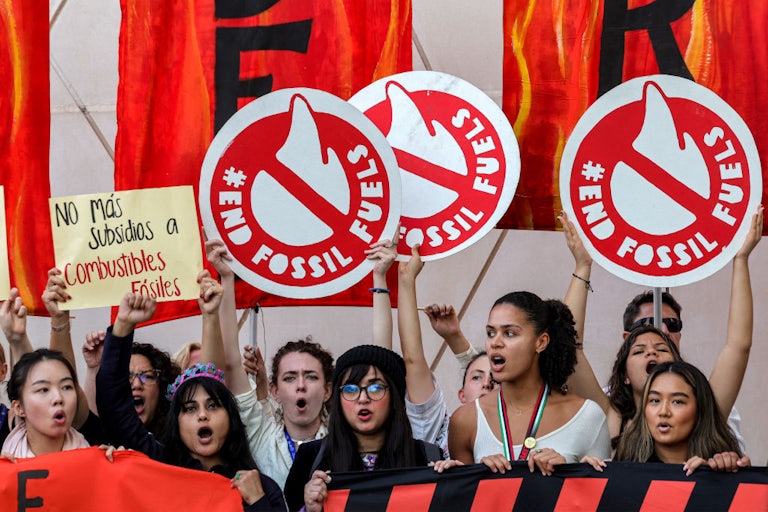The Optimistic Climate Report That Might Be Too Good to Be True
Journalists hailed it as proof that we can grow the economy while cutting emissions. But between the lines, there’s a different story.

A funny thing happened last week. A climate report revealed genuinely good news about U.S. emissions. Or did it?
“U.S. Carbon Emissions Fell in 2023 as Coal Use Tumbled to New Lows,” The New York Times reported. “The falling emissions, driven largely by retirements of dirty, coal-fired power plants, put U.S. climate pollution at its lowest level since 1991,” CNN added. NBC’s headline was cautious—“Good news, bad news: U.S. emissions shrank last year, but very slowly”—but the lede was more optimistic: “Carbon emissions shrank in 2023 even as the economy grew, a sign the U.S. is plodding toward a more sustainable future.”
That was the takeaway of a lot of the coverage. As Robinson Meyer of Heatmap wrote, “It’s the first time since the pandemic began that the American economy has, as the phrase goes, ‘decoupled’—experienced an expanding economy and falling emissions at the same time.” These articles acknowledged that progress remains troublingly slow—the pace isn’t enough to meet the targets set by the Paris Agreement—but characterized the report as proof that we can grow the economy while reducing emissions.
Not so fast. It really depends on what part of the Rhodium report you look at. To quote the summary itself: “This decline in emissions was driven by an 8% drop in emissions in the power sector and a 4% drop from residential and commercial buildings.… In the transportation sector, the highest-emitting sector, emissions rose by 1.6% from 2022 levels, and in the industrial sector, the second highest-emitting sector, there was a 1% increase in emissions.” That’s a little less encouraging.
Consider the 4 percent decrease from buildings. How’d that happen? “In the buildings sector, a milder-than-average winter reduced fuel demand and led to lower overall emissions, since the majority of homes still rely on natural gas, fuel oil, and propane for space heating.” This is a tough one to know how to evaluate. On the one hand, any drop in emissions is good, in that it strictly adds less to the total emissions budget. On the other hand, another way of phrasing this would be to say we reduced emissions by warming the world enough that it was a mild winter, which, given that our buildings still rely on fossil fuels, reduced emissions. That is not a pattern we want to repeat ad infinitum, expecting further success; there are, after all, some knock-on effects from warmer winters, including water crises, ecosystem and agricultural instability, and hotter summers (which can also lead to increased fuel consumption).
Then there’s the power sector. Coal declining is doubtless good news, not just for greenhouse gas emissions but also for human health. But the report also says that “natural gas generation grew more than twice as fast as renewable generation did, year-on-year.” And wind turbine installation rates actually seem to be declining relative to 2021 levels. Meanwhile, the report continues, “the U.S. is on track for record dry gas production in 2023, and crude oil production looks to rival if not exceed 2019 record levels as well.”
And then there’s the other big asterisk. “The researchers looked at planet-warming emissions generated by transportation, electricity, industry and buildings,” The New York Times noted, “but did not include pollution from agriculture, which accounts for roughly 10 percent of the nation’s greenhouse gases.”
There’s little reason to think that U.S. agricultural emissions have gone down. In fact, we already know that agricultural emissions can rise while others fall, because that seems to be what happened in 2020, when Covid hit. Between 1990 and 2021, according to the Environmental Protection Agency’s annual Inventory of U.S. Greenhouse Gas Emissions and Sinks, carbon dioxide emissions from agriculture increased by 16.2 percent, methane emissions increased by 15.7 percent, and nitrous oxide emissions increased by 3.7 percent. And emissions specifically from enteric fermentation—i.e., from the guts of the animals producing red meat and dairy—have increased 7.2 percent over roughly the same period.
None of this is to say that the way the Rhodium findings are being reported is wrong. The top-line summaries, however, emphasize the progress rather than the more troubling signs. Even with all the caveats, Meyer writes, “the analysis nonetheless shows that climate progress in the U.S. is holding its own, just as the Inflation Reduction Act and new Environmental Protection Agency rules are set to kick in in years to come.”
I struggle to match that optimism. None of the sectors where emissions have likely increased are easy to reform, from a political perspective. The sectors where emissions did decrease may not maintain those reductions. Then too, it’s hard to ignore other headlines coming out this week that may have a significant effect on these trends going forward. Hot (so to speak) on the heels of former President Donald Trump’s victory in the Iowa caucus, a poll released Tuesday showed Trump leading Biden 45–37 percent in the key state of Georgia. That same day, Politico reported that team Trump may “show less restraint” in a second term than in his first when it comes to gutting environmental protections and climate policy. That’s in part due to the influence of Project 2025, a policy draft put together by conservative groups for “Day One.” (You can read about Project 2025 and its implications for climate, trans rights, schools, and more in TNR’s extensive coverage of the plan.)
Time will tell how this report from the Rhodium Group ages. It’s a frustrating feature of climate coverage that one of the most important factors in evaluating the meaning of emissions reports often isn’t the climate or emissions data itself but rather the crystal-ball vagaries of American politics. The climate-funding progress of the past few years is real. But the IRA is a law—and an imperfect one, at that. It’s not destiny.
Good News/Bad News
![]()
![]()
Stat of the Week
11,000 pieces
That’s possibly the average microplastic ingestion of an American adult each year, according to a profoundly disturbing piece from The Washington Post on microplastics in food.
What I’m Reading
Fossil Fuel Corporations Are Faking Grassroots Support
Fossil fuel companies have used insights on consumer trust from P.R. firm Edelman to “turn workers into a positive public face for fossil fuels, obscuring the role of the profit-hungry executives who actually pull the strings,” Adam M. Lowenstein reports. The strategy has proven politically profitable.
“Energy Citizens,” an ultimately successful astroturf campaign launched by the American Petroleum Institute while Edelman was the organization’s single largest contractor, hewed closely to Edelman’s proprietary insights about trust. The effectiveness of Energy Citizens, which involved making oil and gas workers the “human face” of the fossil fuel industry to create the impression of widespread grassroots support, contributed to the defeat of US climate legislation in 2010.…
According to Duncan Meisel, executive director of Clean Creatives, such examples illustrate how Edelman has used its insights—under the guise of studying public trust—to help the fossil fuel industry fight climate action. “When Edelman finds that engagement from employees and ‘people like me’ is an important part of developing trust in corporations, you immediately see those tactics being deployed on behalf of the American Petroleum Institute and companies like TransCanada,” said Meisel.
Read Adam M. Lowenstein’s report at Jacobin.
This article first appeared in Life in a Warming World, a weekly TNR newsletter authored by deputy editor Heather Souvaine Horn. Sign up here.









.png)
